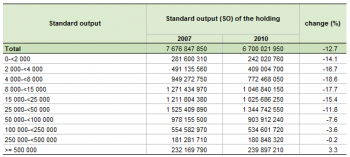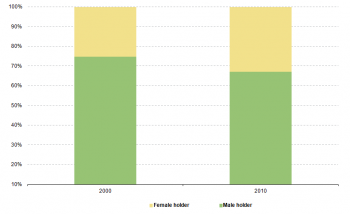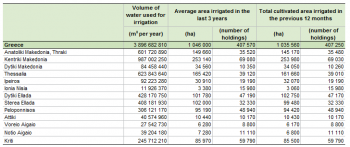Archive:Agricultural census in Greece
- Data from November 2012. Most recent data: Further Eurostat information, Main tables and Database.
This article is part of a series of country-specific essays on the results of the European Union (EU) Farm structure survey (FSS) 2010. The FSS collects information on the structural characteristics of the agricultural holdings (land use, livestock and labour force) and is carried out by all European Union Member States every 10 years as an Agricultural census, with two or three additional, intermediate sample surveys carried out in-between.
The present analysis of the Danish farm structure includes a comparison with the Agricultural census 2000. However, Denmark experienced an extensive regional reform over the inter-census period, which led to the creation of new administrative regions. As a consequence, the NUTS 3 regions used for the FSS 2000 do not generally correspond to the new NUTS level 2 regions applicable in 2010. Therefore, it was not possible to compare regional data for the two reference years (2000 and 2010); the comparative analysis was undertaken only at national level.

Source: Eurostat (ef_kvaareg) (ef_ov_kvaa) (demo_pjan) and FSS 2000 and 2010
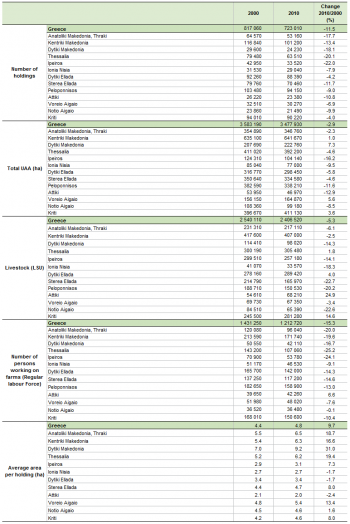
Source: Eurostat (ef_kvaareg) (ef_ov_kvaa) and FSS 2000 and 2010
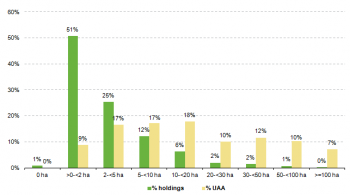
Source: Eurostat (ef_kvaareg) (ef_ov_kvaa)
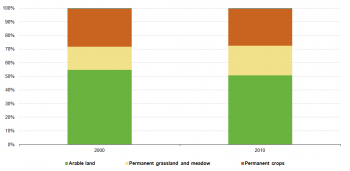
Source: Eurostat (ef_lu_ovcropaa) (ef_oluaareg)
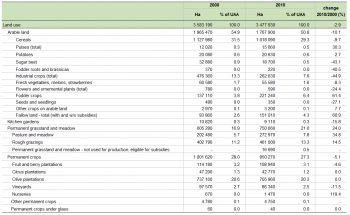
Source: Eurostat (ef_lu_ovcropaa) (ef_oluaareg)
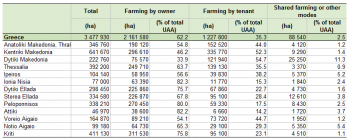
Source: Eurostat (ef_mptenure)

Source: Source: Eurostat (ef_pmhouscatlaa)
Main statistical findings
Key indicators
In Denmark, there were 42 100 agricultural holdings in 2010 (see Table 1); compared to the other Scandinavian countries, both Norway (46 620) and Sweden (71 090) recorded higher values. About 16 000 farms ceased their activities in Denmark (- 27.2 %) over the inter-census period; however, this falling tendency in the number of farms was found to be common among the countries of the EU-27.
The utilised agricultural area (UAA) in Denmark remained fairly stable between the two reference years: it indicated the value of 2.6 million hectares and covered 61 % of the entire country in 2010, which was one of the highest shares recorded among the EU-27.
As the number of farms decreased and the agricultural land remained stable, the average size of the holdings grew (+37.5 %): from 45.7 ha per farm in 2000 to 62.9 ha in 2010. Hence, Denmark proved to be among the EU Member States with the highest average area per farm.
Similarly to the other Scandinavian countries, also in Denmark the number of people regularly working on the farm decreased over the period under analysis (-22 %): in absolute terms, 22 550 people left the agricultural sector over the inter-census period. Thus, the agricultural labour force represented only 2.8 % of the active population[1] in 2010 – the corresponding values in both Sweden (2.9 %) and Norway (5 %) were slightly higher.
As exhibited in Table 1, there were 4.9 million livestock in Denmark in 2010. This value, expressed in livestock units (LSU), indicates a 12.8 % increase compared to 2000 (+557 630 LSU) when about 4.3 million LSU were recorded; both Norway (1.2 million LSU) and Sweden (1.7 million LSU) recorded lower values in 2010.
Agricultural holdings
As presented in Figure 1, three classes of farms proved to be the most common in Denmark as each recorded a share of 19 % over the total population of farms: holdings with 5 to 9.9 hectares of agricultural land, those with 10 to 19.9 ha of UAA and the ones with 100 or more hectares of agricultural area. In terms of the number of farms, holdings with less than 5 hectares of agricultural area shared 7 % (3 060 farms) of the total farm population and accounted for less than 1 % of the Danish agricultural area. On the opposite end of the scale, holdings with 100 hectares or more of agricultural land (8 080 farms) covered about 1.7 million hectares of UAA accounting for 66 % of the country’s agricultural area in 2010.
See detailed data at NUTS 2 level for 2000 and 2010
Economic size of the farm
In 2010, the economic size of the Danish agricultural holdings indicated the value of EUR 8 430 million; as regards the other Scandinavian countries, both Sweden (EUR 3 733 million) and Norway (EUR 3 156 million) recorded lower values. Over the 2007-2010 timeframe, the standard output, which is calculated by adding all the standard output (SO) per hectare of crop and per head of livestock of the farms, increased by 21.9 % in Denmark. The increase was mostly the result of the boost in the Standard Output of the biggest class of farms – holdings with EUR 500 000 or more of standard output – which increased by 48.5 % (+ EUR 1 860 million). The aforementioned class of farms proved to be by far the most important accounting for 67 % of the Danish standard output in 2010. Despite the - 19 % decrease compared to 2007, holdings with the SO of EUR 250 000 to 499 999 proved to play a remarkable role within the structure of the Danish agriculture as they accounted for 15 % of the country’s total value in 2010 (EUR 1 258 million).
From among the Danish territories, the region of “Syddanmark” recorded the biggest economic value (EUR 2 836 million) and accounted for 33 % of the Danish SO; the territory of Midtjylland (EUR 2 660 million) recorded the second highest figure, corresponding to 31 % of the country’s standard output in 2010.
See detailed data at NUTS 2 level for 2010 and 2007
Agricultural holding by main type of farming
In terms of the number of holdings and the main type of farming, farms specialised in cereals, oilseed and protein crops were found to be the most common, as they represented 29 % of the entire population of holdings in 2010 (see Figure 2). Farms specialised in general field cropping recorded the second highest share (12 %); holdings dedicated to sheep, goats and other grazing livestock recorded the only other double digit percentage (10 %).
If the economic size is taken into account, the ranking looks different, indicating that the major role was played by two main types of production, which together accounted for 62 % of the Danish standard output: farms dedicated to pigs (38 %) and holdings specialised in dairy farming (24 %).
See detailed data at NUTS 2 level for 2010
Land use
The Utilised Agricultural Area (UAA) is the total area used by the farm, regardless of the type of tenure or whether it is used as a part of common land. It includes four major components: arable land, permanent grassland and meadow, permanent crops and kitchen gardens.
The agricultural area in Denmark was mostly taken up by arable land (91.4 %) in 2010, which lost about 54 640 hectares compared to 2000 (-2.2 %). On the contrary, permanent grassland and meadow gained 38 840 ha over the timeframe under analysis and indicated the value of 199 860 hectares in 2010.
See detailed data at NUTS 2 level for 2000 and2010
Arable land
In 2010, the Danish arable land was mostly taken up by cereals (1.5 million ha), which covered more than half (55 %) of the country’s agricultural area. Also the production of fodder crops proved to be important, accounting for 21.2 % of the entire agricultural land (562 360), and was found to have gained 151 880 hectares over the inter-census period. Industrial crops shared further 6.3 % and were found to cover 165 720 hectares of agricultural area: + 15 200 hectares compared to 2000.
See detailed data at NUTS 2 level for 2000 and 2010
Permanent grassland
As exhibited in Table 4, the area of permanent grassland covered 7.6 % of the Danish agricultural area in 2010 (199 860 ha). The land dedicated to pasture and meadow represented its largest component (101 260 ha), though it lost 58 270 hectares between the two reference years. On the contrary, the area dedicated to rough grazing gained 34 590 hectares, although it only accounted for 1.4 % of the country’s UAA in 2010.
See detailed data at NUTS 2 level for 2000 and 2010
Livestock
Statistics on livestock use two different units of measurement, the number of heads (number of animals) and the livestock unit (LSU), with the latter allowing comparison between different types.
As presented in Table 5, 26 030 holdings were farming about 4.9 million LSU in Denmark in 2010. Although the number of farms with livestock decreased sharply (-35 %) over the period under analysis, the population of farm animals grew (+ 13 %). As a result, the average number of livestock per farms increased from 108 LSU per farm in 2000 to 189 LSU per holding in 2010. Far from being evenly widespread across all the categories of farms, this growth was recorded only for the biggest type of holdings – those with 500 or more LSU – which registered an increase both in terms of the number of holdings (+78 %) and the livestock population (+ 2 million LSU). Compared to 2000, all other classes of farms recorded losses in terms of the number of farms as well as the population of farm animals.
In Denmark, pigs were found to be the most common livestock, as they indicated the value of 3.5 million LSU (+27 %) and accounted for 71 % of the Danish population of farm animals in 2010. The cattle were the only other livestock with the LSU of more than one million (1.1 million LSU); they represented 23 % of the whole country’s LSU in 2010 despite the fact that they recorded a 15 % decrease compared to 2000.
From among the Danish territories, the regions of “Midtjylland” (33.8%), “Syddanmark” (32.2 %) and “Nordjylland” (22.4 %) proved to play a major role, as 88 % of the Danish livestock was found to be farmed within their borders in 2010. In particular, “Syddanmark” hosted the highest share of cattle (38.6 %), whereas the largest percentage of pigs (35.3 %) was recorded in “Midtjylland”.
See detailed data at Nuts 2 level for 2010 and 2000
Labour force
As presented in Table 6, about 80 000 people were regularly working in the agricultural sector in Denmark in 2010. Compared to 2000, the agricultural labour force decreased by 22 %; in absolute terms, 22 550 people stopped working on the farm. This tendency was observed throughout the EU-27. The decrease in the agricultural labour force in Denmark looks quite similar (-20.71 %) if the annual work unit (AWU) is taken into account, in which case figures dropped by 13 260 AWU between the two reference years.
In 2010, most of the regular agricultural labour force proved to be located in the regions of “Syddanmark” (30 %) and “Midtjylland” (30 %), with the territory of “Nordjylland” also recording a notable share of 19 %. On the contrary, the region of “Hovedstaden” accounted for a marginal 5 % of Danish labour force in 2010.
See detailed data at NUTS 2 level on holders' age and gender for 2010 and 2000
See detailed data at NUTS 2 level on type of labour force for 2010 and 2000
Management practices
Type of tenure
In 2010, the majority (68.8 %) of the Danish agricultural land was found to be farmed by the tenants and regional percentages did not seem to differ much from the national average.
As exhibited in Table 7, the agricultural land farmed by the people who actually owned that land accounted for the remaining 31.2 % of the UAA; there is no land utilised in partnership by the landlord and the sharecropper under a written or oral share-farming contract in Denmark.
Irrigation
In Denmark, the total irrigable area increased by 7.5 % over the decade under analysis: from 446 920 ha to 480 440 ha. In 2010, the area irrigated at least once a year indicated the value of 323 500 hectares and covered 12.2 % of the country’s agricultural area. However, when analysing data on irrigation, it should be kept in mind that the extent of the irrigated area varies over the years according to the weather conditions.
The harvest that had the largest share of irrigation water in 2010 was cereals (excluding maize and rice): it took up 153 730 ha and accounted for about half (47.8 %) of the Danish irrigated area. As exhibited in Figure 7, temporary and permanent grass was the second most irrigated crop (82 740 ha, 26 %), followed by maize (grain and green) – 29 590 ha, corresponding to 6.6 % of the total irrigated area – and potatoes (27 570 ha, 9 %).
In Denmark, about 220 million cubic metres of water were used to irrigate the 323 500 hectares of agricultural area. In relative terms, 680 cubic metres of water were used per hectare of agricultural land in 2010, a value which was calculated taking into account the area irrigated in the 12 months prior to the survey. Information on the amount of irrigation water was obtained through a specific question in the questionnaire; from among the 3 863 farms with irrigation sampled by the SAPM, 833 did not answer the question, in the case of which an imputation was made.
Among the Danish territories, the regions of “Hovedstaden” (893 cubic metre per hectare) received the highest amount of irrigation water, followed by “Midtjylland” (724 cubic metre per hectare); on the contrary, the region of “Nordjylland” reported the lowest amount.
Animal housing
In 2010, 13 580 holdings farmed about 1.6 million heads of cattle in Denmark; as regards the other Scandinavian countries, both Sweden (21 590) and Norway (16 900) recorded a higher number of farms with cattle.
If the number of holdings is taken into account, the most common type of animal housing was the one were the animals are free to move with solid dung and liquid manure (9 400 holdings), followed by the other type of loose housing (5 070).
In terms of number of places, the ranking is reversed, as the loose housing with slurry recorded a higher value (887 010 places) than the type of housing were the cattle are free to move with solid dung and liquid manure (538 680). Similarly to many other EU member States, the number of places for cattle in Denmark was higher than the number of heads of cattle, which explains why the related ratio is higher than 100.
Other gainful activities
As presented in Table 10, there were 21 900 farms with other gainful activities in 2010 in Denmark. Representing more than half (52 %) of the Danish population of agricultural holdings, these farms registered activities other than farm work, directly related to the holding and having an economic impact on it; as regards the other Scandinavian countries, both Norway (25 500) and Sweden (24 050) recorded higher values.
Information on other gainful activities was collected by eleven category types depending on their characteristics – one holding could register more than one activity. Forestry work (12 950 farms) was by far the most common type of extra activity, followed by contractual work (6 400 farms), which could take the form of contractual agricultural work (5 420 holdings) and contractual non-agricultural work (2 420 farms).
Among the Danish regions, “Midtjylland” (6 950 farms) and “Syddanmark” (6 180 farms) recorded the highest values and accounted respectively for 32 % and 28 % of the population of holdings with extra sources of income.
Organic farming
Organic agriculture is an ecological production management system that promotes and enhances biodiversity, biological cycles, and soil biological activity. It is based on the minimal use of off-farm inputs and on the management practices that restore, maintain or enhance ecological harmony.
Although the number of holdings practicing organic farming decreased over the period under analysis (-17 %), the agricultural area under this practice increased slightly (0.7 %). Nonetheless, in 2010, the area under organic farming covered a marginal 5.7 % of the Danish agricultural area; compared to the other Scandinavian countries, Sweden (310 060 ha) reported a higher area under organic farming, whereas Norway recorded a lower value (43 740 ha).
See detailed data at Nuts 2 level for 2010, 2007, 2005, 2003 and 2000
Data sources and availability
Methodological notes Greece – Agricultural census 2010
The FSS 2010 was conducted by the division responsible for agricultural statistics of Statistics Denmark. The Agricultural Census, in its present form, goes back to 1977 when the surveys on agriculture and horticulture were integrated. Since then, the survey has been carried out every year, though not always in an extensive form.
Survey on agricultural production methods (SAPM)
In 2010 a unique survey was carried out together with the Agricultural census, the Survey on agricultural productions methods (SAPM). This survey collected data at regional level needed to establish agri-environmental indicators as indicated in COM final 508/2006 and to evaluate the greening of the Common agricultural policy.
Data were collected according to the specifications listed in Annex V of the above mentioned regulation, namely data on tillage methods, soil conservation, landscape features, animal grazing, animal housing, manure application, manure storage and treatment facilities and irrigation.
In Denmark, the SAPM was conducted as a sample survey; a stratified sampling method was used to select 15 005 holdings from the population of 42 100.
Reference period
Information on the structure of the Danish agriculture was collected as of the 14th of May 2010. However, data on the labour force, including other gainful activities, refer to the one year prior to the reference date. Furthermore, information on rural development characteristics was collected as of the calendar year 2008-2010.
Contrary to the FSS, the SAPM took place in 2011 and the reference period is July 2011. Nonetheless, information on tillage methods and manure application concerns the crop year (October 2009 – September 2010) prior to the reference date.
Threshold for agricultural holdings
In compliance with the EU regulation 1166/2008, Statistics Denmark surveyed all agricultural holdings having at least 5 hectares of agricultural area or a standard output of at least EUR 7 500. Moreover, all farms falling below this threshold but complying with a set of different physical thresholds (related to the square metres of certain types of crops or heads of livestock) were also included in the target population.
In Denmark, the thresholds for excluding the smallest units from the survey have been revised over the years. In particular, the new thresholds introduced with the EU regulation 1166/2008 led to the inclusion of 431 more farms in the Danish farm structure census 2010. In addition, Denmark also chose to include farms with furred animals from 2010 onwards, which resulted in further 736 farms added to the 2010 population. Overall, these 1 167 extra farms, which would not have been included had the old standard still been in force, account for 2.8 % of the farms in Denmark, 0.03 % of the Danish agricultural area and 0.07 % of the number of the country’s livestock units.
Common land
Common land is the land that does not directly belong to any agricultural holding but on which common rights apply. It can consist of pasture, horticultural or other land. The treatment of the common land used by an agricultural holding might differ from country to country.
In Denmark, common land is a non-existent characteristic, as all the agricultural area belongs to somebody. For these reason, common land has never been covered by the Farm Structure Survey in this country.
Geo-reference of the holding
In Denmark, information on the location of the farms is stored in the Danish business register and refers to the address of the head quarter of the holding.
Economic size
From FSS 2007 onwards, the Standard output (SO), a new classification of the economic size of the holding, is used. The SO has replaced the Standard gross margin (SGM) used before. Nonetheless, for comparability reasons, in FSS 2007 both classifications are available.
Other methodological issues
In Denmark, following an extensive regional reform, new administrative regions were created and new NUTS level 2 regions were defined in 2006. The previous NUTS 3 regions used for the FSS 2000 do not generally correspond to the new NUTS level 2 regions applicable in 2010; therefore, it was not possible to compare regional data for years 2000 and 2010.
Context
European Commission Rural development policy aims to improve competitiveness in agriculture and forestry, the environment and the countryside, as well as to improve the quality of life in rural areas, and to encourage the diversification of rural economies.
As agriculture has been modernised and the importance of industry and services within the economy has increased, agriculture has become much less important as a source of jobs. Consequently, increasing emphasis is placed on the role farmers can play in rural development, including forestry, biodiversity and the diversification of the rural economy, in order to create alternative jobs and provide environmental protection in rural areas.
The FSS continues to adapt in order to provide timely and relevant data to help analyse and follow these developments.
Further Eurostat information
Publications
- Agriculture, fishery and forestry statistics — Main results – 2010-11 - 2012 edition
- Farm Structure Survey in Denmark - 2007 - Issue number 80/2008
- Farm Structure in Denmark - 2005 - Issue number 18/2006
Main tables
- Agriculture, see:
- Structure of agricultural holdings (t_ef)
Database
- Agriculture, see:
- Structure of agricultural holdings (ef)
Dedicated section
Methodology / Metadata
- Structure of agricultural holdings (ESMS metadata file - ef_esms)
- Methodological Report - FSS 2010 Denmark
- Methodological Report - FSS 2007 Denmark
Source data for tables and figures (MS Excel)
Other information
- Regulation 1166/2008 of 19 November 2008 on farm structure surveys and the survey on agricultural production methods and repealing Council Regulation 571/88
- Regulation 1200/2009 of 30 November 2009 implementing Regulation 1166/2008 on farm structure surveys and the survey on agricultural production methods, as regards livestock unit coefficients and definitions of the characteristics
See also
External links
Notes
- ↑ A value calculated over the total number of active people aged 15 to 64, as it is reported by the 4th quarter 2010 of the EU Labour force survey (LFS) Population by sex, age, nationality and labour status (1 000)
